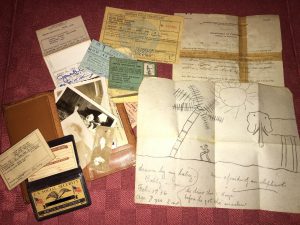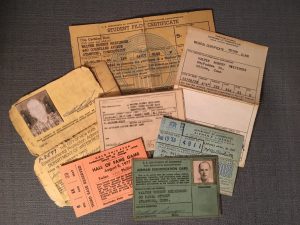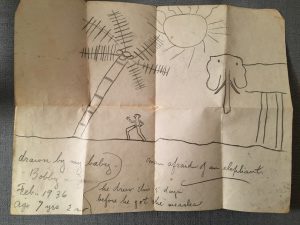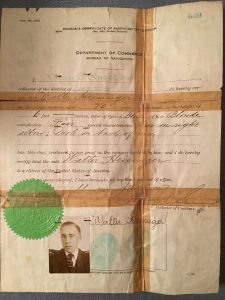 My grandfather (Walter Robert "Bob" Heisinger, a.k.a. Poppa) was notorious for carrying around a gigantic wallet bursting at the seams with photographs, business cards, and other little mementos he picked up over the years. He would often pull bits and pieces out at social gatherings as props to his stories and jokes. I remember harassing him as a teenager that the thickness of the wallet was contributing to his hip problems and I made a box for him to store some of its contents, though I am sure the box remained empty for the rest of his life.
My grandfather (Walter Robert "Bob" Heisinger, a.k.a. Poppa) was notorious for carrying around a gigantic wallet bursting at the seams with photographs, business cards, and other little mementos he picked up over the years. He would often pull bits and pieces out at social gatherings as props to his stories and jokes. I remember harassing him as a teenager that the thickness of the wallet was contributing to his hip problems and I made a box for him to store some of its contents, though I am sure the box remained empty for the rest of his life.
 Recently, my grandmother gave Poppa’s billfold to my father. This was not the infamous bursting wallet, but another that he also took with him everywhere. I was excited to go through its contents to be reminded of the treasures I had seen him pull out a million times before and discover what he kept inside that he did not share with the world. For starters, he carried with him several of his airman’s licenses. He apparently never discarded of any of them and just kept collecting them each time he received a new one. Amongst these was also a ticket to the Baseball Hall of Fame from 1977, a trip my father remembers taking with him. It was obviously a memory my Poppa treasured as well.
Recently, my grandmother gave Poppa’s billfold to my father. This was not the infamous bursting wallet, but another that he also took with him everywhere. I was excited to go through its contents to be reminded of the treasures I had seen him pull out a million times before and discover what he kept inside that he did not share with the world. For starters, he carried with him several of his airman’s licenses. He apparently never discarded of any of them and just kept collecting them each time he received a new one. Amongst these was also a ticket to the Baseball Hall of Fame from 1977, a trip my father remembers taking with him. It was obviously a memory my Poppa treasured as well.
He also had several photographs from his childhood – many of family members, but also of himself. One that I had seen many times was my Poppa as a child wrapped in bandages from head to toe after getting poison ivy. The mummified look seemed a bit dramatic as a response to poison ivy, but it fits the personality of the person that kept the photograph to display to others decades afterward. The joke continues today, as I can’t help but laugh every time I see it.
 I got another good laugh at a drawing I had never seen before. Delightfully titled “Man afraid of an elephant,” it depicts a man running away from an elephant with a note from my great-grandmother that it was drawn by Poppa in February 1936, when he was nine years and two months old. She also noted that he drew this five days before he got the measles. I guess we’ll never know why Poppa kept this drawing for his entire lifetime, but my guess is that there is a joke in there somewhere.
I got another good laugh at a drawing I had never seen before. Delightfully titled “Man afraid of an elephant,” it depicts a man running away from an elephant with a note from my great-grandmother that it was drawn by Poppa in February 1936, when he was nine years and two months old. She also noted that he drew this five days before he got the measles. I guess we’ll never know why Poppa kept this drawing for his entire lifetime, but my guess is that there is a joke in there somewhere.
 To my surprise, not all the contents pertained to my grandfather. Once such piece was the Seaman’s Certificate of American Citizenship issued to my great-grandfather, Walter Heisinger, in 1917, when he was only 20 years old. The document, taped at the creases where it had been folded for years, included Walter’s picture and his fingerprints as well as his physical description. I had no idea that this document existed, let alone that Poppa carried it with him daily. This must have been something of his father’s that was particularly special to him.
To my surprise, not all the contents pertained to my grandfather. Once such piece was the Seaman’s Certificate of American Citizenship issued to my great-grandfather, Walter Heisinger, in 1917, when he was only 20 years old. The document, taped at the creases where it had been folded for years, included Walter’s picture and his fingerprints as well as his physical description. I had no idea that this document existed, let alone that Poppa carried it with him daily. This must have been something of his father’s that was particularly special to him.
All the items in his billfold were from years past, and none of them necessary to carry with him in the latter years of his life except as a reminder that those memories and people most dear to him were close to his heart. (He kept the billfold in his jacket pocket.) They also served as conversation pieces and a way to relive the past. I once thought it absurd to carry a lifetime of items every day. Now I know that the items he carried were badges of honor for him and told the story of his life, silly and ridiculous as they may seem, and that they were uniquely Poppa.
Share this:
About Meaghan E.H. Siekman
Meaghan holds a Ph.D. in history from Arizona State University where her focus was public history and American Indian history. She earned her B.A. in history from Union College in Schenectady, New York, the city where she grew up. Prior to joining the NEHGS team, Meaghan worked as the Curator of the Fairbanks House in Dedham, Massachusetts, as an archivist at the Heard Museum Library in Phoenix, Arizona, and wrote a number of National Register Nominations and Cultural Landscape Inventories for the National Park Service. Meaghan is passionate about connecting people with the past in meaningful and lasting ways. She enjoys finding interesting anecdotes about an ancestor to help bring the past to life.View all posts by Meaghan E.H. Siekman →